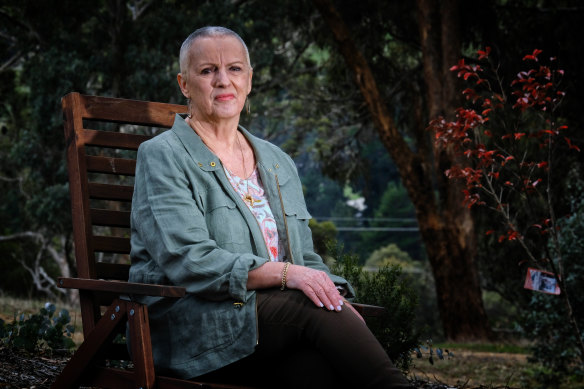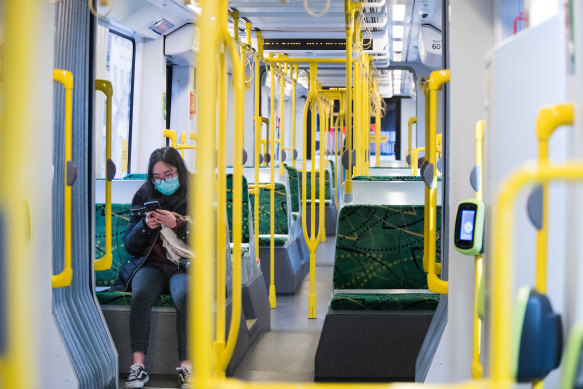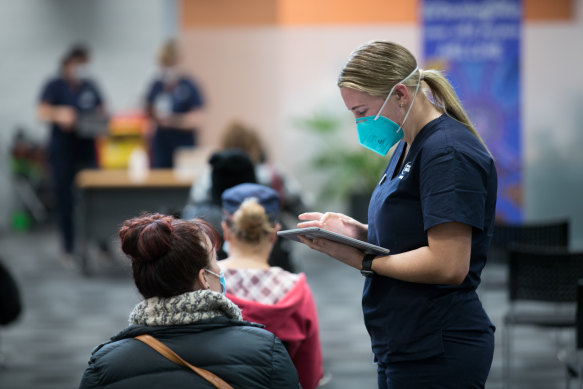This was published 1 year ago
We’re living with COVID but more of us are dying than ever
By Chloe Booker and Najma Sambul
For two years, Australians held their collective breath, waiting to hear the daily COVID-19 case numbers.
We gasped when they hit the hundreds in 2020, celebrated “doughnut days” when Victoria’s sixth lockdown in 2021 ended, and stayed home by choice when they soared to the tens of thousands as Omicron took hold early this year.

Karen Dawson, who is recovering from a mastectomy after being diagnosed with breast cancer, says it’s hard to watch people let their guard down while others with compromised health had to remain cautious about COVID.Credit: Luis Ascui
But sometime between then and now, we – or most of us – let out a sigh of relief, shrugged our shoulders and committed to the oft-repeated slogan “living with COVID”.
The daily COVID-19 press conferences stopped, restrictions eased, and we tuned out and got on with our lives.
Since then, deaths from the virus have reached 7495 in Australia, according to health department data.
In the first four months of this year alone, there have been more than twice as many deaths than in the rest of the pandemic, with 5269 recorded as of Saturday.
COVID-19 went from being the 38th leading cause of death in 2020 to the second, behind cancer, in January this year, according to provisional mortality data released by the Australian Bureau of Statistics.
The COVID-19 deaths – those doctor certified and coroner referred, meaning there could be more to be reported – led to a 22.1 per cent increase in overall deaths compared with the January average.
This statistic, known as excess mortality, is important as it tells us Australians are dying from the virus rather than from another cause while they are infected.
While more than three-quarters of COVID-19 deaths in Australia have been people aged 70 and over, they include eight children aged under nine, five 10-to-19 year olds, and 30 people in their 20s.

A lone passenger on a Melbourne tram.Credit: Jason South
Epidemiologist Mike Toole, an associate of Melbourne’s Burnet Institute, said he was astonished that the increase in deaths wasn’t being addressed during the federal election campaign.
“We were told earlier in the year don’t look at the case numbers, look at hospitalisations, ICU admissions and deaths,” Toole said. “I’ve been looking at them and they’re going up.”
Toole estimated that the virus would be in the top five leading causes of death for 2022.
He noted that there has been 272 COVID-19 deaths in the past week.
“I learned that a Boeing 737-800, which is the most common domestic plane used in Australia, carries 184 passengers and crew,” he said. “So, we’re reporting more than a 737 crashing every week.”
Victoria recorded 502 COVID-19 cases in hospital on Friday, the first time the number has exceeded 500 since February 11. The state, meanwhile, surpassed 3000 COVID deaths this week, almost half of which occurred this year.
It is still the state with the highest number of deaths, despite NSW recording the most so far in 2022.
The reason Australia is recording so many deaths is not due to a high death rate, but instead increased transmission and cases.
Since mid-April, we have been either first or second in the world for new COVID-19 cases per person, trading places back and forth with New Zealand.
This doesn’t include countries with fewer than 200,000 people and doesn’t account for US under-reporting due to the country not mandating the reporting of positive rapid antigen tests.
Meanwhile, hospitalisations doubled across Australia between March 12 and April 24 – mostly in NSW and Queensland – and have continued to rise.
But while cases, and therefore deaths, are soaring, the fatality rate has been decreasing.
In 2020, we had 900 deaths from 28,000 cases – one in every 31 cases – while in 2021 we had 1330 deaths from 360,000 cases, or one in 271. This year, we’ve had more than 5000 deaths, but we’ve had 5.4 million cases. That’s one in 1080 cases.
The difference is that we’re now highly vaccinated and the Omicron variant is milder than its predecessor, Delta.
Toole said he was troubled that we were heading into winter – when COVID rates could rise – with our heads in the sand.
He said both political parties were avoiding the subject: Labor because it doesn’t want people to think it’s planning more lockdowns and the Coalition because it wants us to focus on its earlier success in handling the pandemic.
Professor Nancy Baxter, head of the School of Population and Global Health at the University of Melbourne, said both parties federally were running campaigns as if COVID-19 didn’t exist.
“[It’s the] the biggest medical emergency or challenge that we’ve ever faced, and continue to face, and yet you hear nothing,” she said. “There’s no actual meaningful discussion or debate around management of the pandemic.”
In Victoria, Baxter said Premier Daniel Andrews, who faces an election in November, also no longer wants to be attacked over strict restrictions in the state.

While COVID cases and deaths are surging, the fatality rate has been decreasing.Credit: Jason South
She said low childhood vaccination and third-shot booster rates, along with the relaxation of mask and isolation restrictions while still in the peak of the Omicron wave, were leading to increased transmission.
“It’s the [more than] 1000 people who have died in April who have lost out,” she said. “There’s more people sick, more people dying and more people with long COVID.”
Baxter worries that if cases increase again with a new variant, Australians won’t be willing to wear masks or stay home again.
“We’ve been told ‘this is over, and it’s done, and we shouldn’t have to worry about that any more’,” she said.
Karen Dawson, who is recovering from a March mastectomy after she was diagnosed with breast cancer, said it was hard to watch people let their guard down while she and others with compromised health had to remain cautious.
“The more vulnerable people have been forgotten,” she said. “There [are] people you talk to who don’t take it seriously, who say ‘it’s just a cold’. It’s irresponsible.”
Although she finds people’s complacency frustrating, Dawson, who was hospitalised twice and lost 20 kilos during chemotherapy, said she preferred to focus on what she could do to stay safe.
Her husband, Paul, suffers from a rare chronic illness. The couple, who live in Kilmore, north of Melbourne, don’t see friends or family who have had COVID for a few weeks after their infections.
Dawson only goes shopping in quiet times, doesn’t take public transport, and leaves events early to avoid crowds.
“People have got to stop brushing it aside,” she said. “There’s a lot of vulnerable people out there.”
Stay across the most crucial developments related to the pandemic with the Coronavirus Update. Sign up for the weekly newsletter.